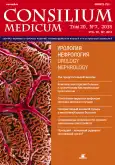The role of combined viral infection in the genesis of various cancers, such as breast cancer, cervical cancer, oropharyngeal localization of the tumor process is being actively discussed. The aim of the study was to identify possible morphological, immunohistochemical features of the bladder tumor against the background of a combined viral infection. 100 patients (72 men and 28 women) aged 38 to 90 years (mean age 65±10) with a diagnosis of bladder cancer were examined and treated. In addition, molecular genetic, serological methods for the diagnosis of viral infections (herpes type 1 and 2, cytomegalovirus - CMV, Epstein-Barr virus - EBV, human papillomavirus - HPV of high oncogenic risk), morphological and immunohistochemical studies were performed. The indicators of proliferative activity, factors of angiogenesis, growth factors depending on the degree of anaplasia and the stage of the process are analyzed. Results. The expression of EGFR in patients with the presence of viral DNA in tumor tissue correlated with the presence of HPV in the tumor (R=0.354, p=0.115), p63 (R=0.707, p=0.182), p53 (R=0.499, p=0.025), Ki67 (R=0.747, p=0.05) and also with the level of anti-EBV Ig-VCA (R=0.47, p=0.032). In patients with the presence of EBV in tumor tissue, expression of growth factors correlated with the level of anti-EBV Ig-VCA (R=0.577, p=0.049), the presence of coylocytosis (R=0.368, p=0.24) and intranuclear inclusions (R=0.485, p=0.11) as manifestations of HPV infection. In patients with no viral DNA there is a slight degree of cytopathic changes (2 points: 10.3% vs. 28.6%, p=0.046), whereas in the presence of viral DNA the degree of these changes is higher (3 points: 27.6% vs. 9.5% respectively, p=0.06). The same situation can be observed in the case of the presence of intra-nuclear inclusions (1 point: 10.7% vs. 28.6%, p=0.046; 2-3 points: 17.9% vs 9.5% and 11.9% respectively). High correlation links between proliferative activity and the presence of high oncogenic risk HPV in tumor tissue were obtained (R=0.706, p=0.05), koilocytosis and factors of angiogenesis (R=0.576, p=0.008) and markers of proliferation (R=0.408, p=0.316). Moderate correlations were found between the presence of intracardiac inclusions and the presence of EBV in tumor tissue (R=0.303, p=0.04), coilocytosis (R=0.411, p=0.005), focal hyperplasia (R=0.459, p=0.001), perivascular infiltration (R=0.335, p=0.023). The presence of CMV in tumor tissue was correlated with focal hyperplasia in the form of follicles (R=0.362, p=0.012), coilocytosis (R=0.32, p=0.028), the presence of leukocytes (R=0.439, p=0.012) and eosinophils (R=0.439, p=0.012). Conclusion. The signs of a combined viral infection are to be determined both in patients with the presence and absence of viral DNA in the tumor tissue. Correlation interrelations between morphological, molecular genetic, immunoenzyme indicators of presence of virus co-infection in patients with bladder cancer are determined. Increased proliferative activity, expression of apoptosis factors, growth factors in patients with the presence of viral DNA in tumor tissue indicates an unfavorable course of the tumor process
 8-10
8-10


 11-14
11-14


 15-19
15-19


 20-25
20-25


 26-29
26-29


 30-36
30-36


 37-40
37-40


 41-45
41-45


 46-50
46-50


 51-55
51-55


 56-60
56-60


 61-62
61-62


 63-68
63-68


 69-72
69-72







